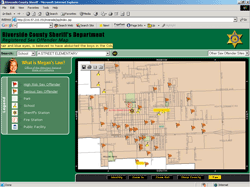Online Mapping Assists Megan's Law Notification
Law enforcement has always been about information management. Community policing emphasizes cooperation through information sharing between law enforcement agencies and community residents. Internet mapping applications developed by police and sheriff's departments have made up-to-date information on burglaries, thefts, and other crimes readily accessible by the public. Recently, many jurisdictions have implemented GIS-based Web sites in response to a 1996 law that authorized state and local law enforcement agencies to notify residents of the presence of registered sex offenders in their neighborhoods.
 |
| The Riverside County Sheriff's Department Web site shows the approximate location of offenders returned from a search. |
Known as Megan's Law, H.R. 2137 amended the Jacob Wetterling Crimes Against Children and Sexually Violent Offender Registration Act of 1994 which requires states to register individuals convicted of sex crimes against children. Megan's Law provides public access to information on sexually violent offenses and offenders while protecting the confidentiality of victims.
Megan's Law was named in honor of Megan Kanka, a seven-year-old New Jersey girl who was raped and murdered by a twice-convicted sex offender who lived in her neighborhood. While not intended to punish offenders, the law authorizes local law enforcement to notify the public about high-risk and serious sex offenders who reside in, are employed in, or frequent the community. Using this information to harass or commit any crime against an offender is specifically prohibited by the law.
Many jurisdictions have opted to provide notification through GIS-enabled Web sites. Some have taken advantage of GIS capability within the government enterprise; some are utilizing solutions from Esri business partners; and some have adopted a hybrid approach, using in-house expertise for some of the implementation and contracting out when necessary. The information available from each site depends on the specific implementation of Megan's Law that was adopted in that state. Some sites include subject descriptions and photographs of offenders considered at high risk for recidivism while others supply approximate locations of offenders and require residents to visit a law enforcement agency office to view more specific information.
According to a report made to the California Legislature in July 2002 entitled California's Sex Offender Information—Megan's Law, the state had more than 93,000 registered sex offenders as of December 31, 2001. Based on past criminal convictions, slightly less than 81 percent were classified as serious offenders with 2 percent designated as high risk.
The Sheriff's Department in Riverside County is one of the jurisdictions in California that has implemented a Megan's Law Web site. The site was developed jointly by the Sheriff's Department, County of Riverside Transportation and Land Management Agency (TLMA), and ESRl's Implementation Services. Because Megan's Law Web sites typically experience high traffic levels, ArcIMS, ArcSDE 8.2, and the Implementation Services' Sex Offender Site Starter Solution were used to build the Riverside County site. Several tools were also created by Implementation Services to optimize handling the volume of visitors to the site.
Users can query data provided by the United States Department of Justice and State of California Department of Justice for the presence of sex offenders in specific neighborhoods and school zones and residential areas near parks and public facilities. If offenders are found in the search area, their approximate locations are displayed on a map. Serious offenders are indicated by orange flags; red flags denote those considered at high risk for reoffending. With this information, concerned citizens can make an appointment to visit the Riverside County Sheriff's Department or contact a city station to make an appointment to view the sex offender database. The database provides information that includes the offender's name, a basic physical description, ZIP Code, and photograph. As stipulated under California law, no street name or specific location information (other than a ZIP Code) is supplied.
During its first three weeks in operation, the site drew more than five million visitors. "It should be available to everyone in the county. It's an important issue. The public needs to know where these people are. We know from past history that a lot of these people are repeat offenders," said Riverside County Sheriff-Elect Bob Doyle. For more information, please contact Lt. Steve Hill, Riverside Sheriff's Department at shill@rc-lawnet.org; Bill Mumbleau, County of Riverside Transportation and Land Management Agency at wmumblea@co.riverside.ca.us; or Craig Morgan, Esri Implementation Services at cmorgan@esri.com.
|